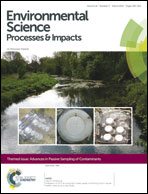Quantitative passive soil vapor sampling for VOCs- part 3: field experiments†
Abstract
Volatile organic compounds (VOCs) are commonly associated with contaminated land and may pose a risk to human health via subsurface vapor intrusion to indoor air. Soil vapor sampling is commonly used to assess the nature and extent of VOC contamination, but can be complicated because of the wide range of geologic material permeability and moisture content conditions that might be encountered, the wide variety of available sampling and analysis methods, and several potential causes of bias and variability, including leaks of atmospheric air, adsorption–desorption interactions, inconsistent sampling protocols and varying levels of experience among sampling personnel. Passive sampling onto adsorbent materials has been available as an alternative to conventional whole-gas sample collection for decades, but relationships between the mass sorbed with time and the soil vapor concentration have not been quantitatively established and the relative merits of various commercially available passive samplers for soil vapor concentration measurement is unknown. This paper presents the results of field experiments using several different passive samplers under a wide range of conditions. The results show that properly designed and deployed quantitative passive soil vapor samplers can be used to measure soil vapor concentrations with accuracy and precision comparable to conventional active soil vapor sampling (relative concentrations within a factor of 2 and RSD comparable to active sampling) where the uptake rate is low enough to minimize starvation and the exposure duration is not excessive for weakly retained compounds.

- This article is part of the themed collection: Advances in Passive Sampling of Contaminants

 Please wait while we load your content...
Please wait while we load your content...